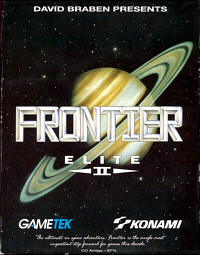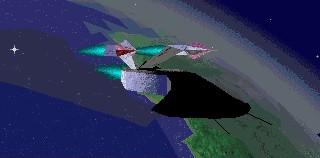Frontier
| Frontier: Elite II | |
|---|---|

| |
| Developer | David Braben |
| Publisher | Gametek |
| Latest version | 1.06 (Shareware) |
| Release date(s) | 29th October 1993 |
| Platform(s) | PC, ST, Amiga |
Frontier was the first sequel to the classic Elite game. Its full title was Frontier: Elite II. It was developed by the fledgling Frontier Developments company founded by co-author of the original Elite game David Braben. It was published by Gametek in October 1993, and made available for most popular systems of the time, including IBM Compatibles, Amiga and Atari ST. The game box came packed with goodies, including a huge manual, a Gazetteer, a book of short stories and a poster depicting the Core Systems.
Frontier expanded the universe of Elite to encompass the entire galaxy, with one of the main selling points being the fact that the creators had accurately mapped our galaxy. Frontier also introduced a Newtonian flight model instead of the usual reactive flight model used in games until that point, adding a new level of realism.
Contents
Analysis
Many rumours abounded following the release of the game that Frontier was never intended to be a sequel to Elite, and was simply written as a new space simulation. The rumour states that someone suggested tacking the Elite ships onto the game, and the decision was eventually made to include the popular elements from Elite into the game, including Lave and the surrounding systems and the ships from the older game. This, although never confirmed to this author's knowledge, does explain why there are very few other elements of Elite present in the game other than the most well known systems and the ships.
In Frontier, the political environment changed considerably from Elite. The Galactic Co-operative of Worlds was no more, and instead there were two opposing factions: the Federation based on Earth and the Empire based in the Achenar system. There was no sign of the Thargoids, and a real time system was used for the first time, setting Frontier in 3200.
The gameplay was considerably tweaked. Frontier still retained the generally open-ended style, where the player could take control of their own destiny, but additional elements were introduced. The player could now undertake missions of many types ranging from delivering packages to assassinating fellow pilots. Military missions for both Federation and Empire were also included.
Pilots could, for the first time, fly in the atmosphere of a planet, and could even land at a planetside starport. Those with the required piloting skills (and patience) could land anywhere on a planet, and even drop a mining rig when they got there!
The choice of ships was also greatly improved - most of the ships from the original Elite made an appearance (apart from the imposing Fer-de-Lance) and were joined by another whole fleet of ships from the humble Eagle Mk I (the starting ship) to the mighty Imperial Courier.
Frontier's control system is the aspect of the game that garners most debate. Many feel that the Newtonian physics detract from the gameplay and make combat almost unbearable. Others claim that the physics enhance the game and turn it into a hybrid of fun game and simulator.
Frontier was also plagued with bugs and quirks due to an alleged rushed release. The tale goes that Frontier Developments were not ready to release the game but Gametek forced the issue, stating that the project had been delayed long enough. As a result, many features that were to be implemented were half finished, and the game was unstable. A series of patches were released that repaired most of these errors. Those who have hacked into the code for the game have reported that there are a great many tags and references in the code for other equipment and game elements, including cloaking devices and Thargoids. This mess resulted in a long series of legal issues that were only resolved in 1999.
Frontier Developments released a shareware version of the game to the legions of fans through the Elite Club website. This version includes all the post-release patches and removes the copy protection schema, although Frontier Developments have neglected to complete the alleged missing code and there remain a number of now well known bugs. Also available is GLFrontier, a reverse-engineered version of FE2 that allows OpenGL rendering.
In summary, Frontier was a playable and fun game, but missed out on truly legendary status through several complaints, amongst them being the bug-ridden beginnings and the troublesome control system. It has, however, gained a faithful and vociferous following of its own with many people still playing the game over a decade after its release, as well as creating fan fiction set in the Frontier universe.
The sequel to Frontier was First Encounters.
Further Critique
- Question: Would implementing physics enhance or ruin Oolite?
- Answer (jonnycuba): Please no! Frontier etc were lame ducks because of the dreaded *N* word... (ie Newtonian modelling).
- Response (Winston (2005)):
No they weren't. Frontier and FFE's problem was nothing to do with using proper laws of motion, but everything to do with limited AI, bugs, more bugs and a very poor implementation of ship control. FFE ship control is about as advanced as those old Tandy "forward and reverse turn only" radio controlled cars.
Using the laws of motion had absolutely nothing to do with FE:2 and FFE's shortcomings. But even with the lousy controls (and with the help of JJFFE where you can control all of the thrusters, even if it's only off or full on) with practice you can have a lot of fun dogfighting.
The advantages of proper laws of motion and more realistic star systems is you can have a lot of fun. You can actually do the orbital calculations on paper and try them out in FFE - and you get a stable orbit. It is impossible to orbit a planet in any version of classic Elite (including oolite) due to the games lacking the proper laws of motion. FFE allowed some great flights of fancy, like visiting a superdense white dwarf and trying to set up an orbit by hand that lasted more than a few revolutions!
The other broken-ness about FE:2 and FFE was the appalling frame of reference changes, which have largely been rectified by the most recent versions of JJFFE.
A version of Oolite with its superior graphics would be AWESOME with the proper laws of motion plus a decent method of ship control. The trouble with all the 'classic' Elites (including Oolite) is that they seem so small. The stars are only a few hundred km from the planets - the reality is Earth vs Sol is 150 million km - about five orders of magnitude greater than in the classic Elite universe! Despite the shortcomings of FFE, it did at least capture the enormity of space.
The trouble is making a game with the real laws of motion and properly scaled solar systems and a decent combat system will be an incredibly tough nut to crack. It would take a very large number of round tuits to do well. The beauty of classic Elite is that it's much simpler to implement, and more time can be put into game play - so it'll be a tradeoff (especially with what is essentially a one-man project). So on the whole I'd prefer a game with the richness in the game play rather than the physics model, so I think Aegidian picked the right tradeoff. (Note that all the other attempts at a better FFE have failed dismally - but all the serious attempts at new classic Elites have succeeded).
Links
Internal
- Quirks of Frontier as a game
- Frontier Fiction
- Lore & History for an overview of how Frontier/FE2/FFE have impacted on Oolite
- More personal views of Winston who wrote much of this page. Leads into an extended discussion of Player Centricism in games.
- Issues with Frontier Dr Nil & Arexack_Heretic (2007)
- More discussion of issues with Frontier - with links to other earlier threads (2008)
- Cim's analysis of Frontier vis-a-vis Classic Elite (2013).
The Elite gaming family
- Classic Elite
- First Encounters (FFE)
- Elite: Dangerous (E:D)
External
All working in Dec 2020
- Alioth.net - link to the other non-wiki part of this website (written by our host, Dylan Smith).
- AndroidArts Some interesting musings as well as paper models!
- Dream-ware - a clutch of 5 different Frontier sites (Sirocco, Kelpie, R3, Longhaul & Mufossa).
- FrontierAstro - Commander Steve's excellent site
- Frontierverse - Frontier: Elite II Home site
- PlanetMic.com - includes links to various expansions
- Life 0n the Frontier
- DOS Days (Old PC Computing Resource) - data on the hardware in those days
Pioneer
- Pioneer
- Pioneer does for Frontier what Oolite did for Elite. It so far has some 20-odd mods or oxp-equivalents.
- YouTube film comparing Pioneer to Oolite (Exploring the Ooniverse #11: Warp Problems by BlueZedPS, 2016)
Bringing Frontier into Oolite
- See Make Frontier ships & features into OXP (2010-12)
- But see also Cody's 2013 post here.
Ships
Much work was done on this by Selezen, User:ADCK, Dertien & Reval. The first three recreated Frontier ships within Oolite, Reval transformed the Oolite ships to match their Frontier specs.
Other oxp's
- Frontier style map.oxp
- Jameson Faces.oxp
